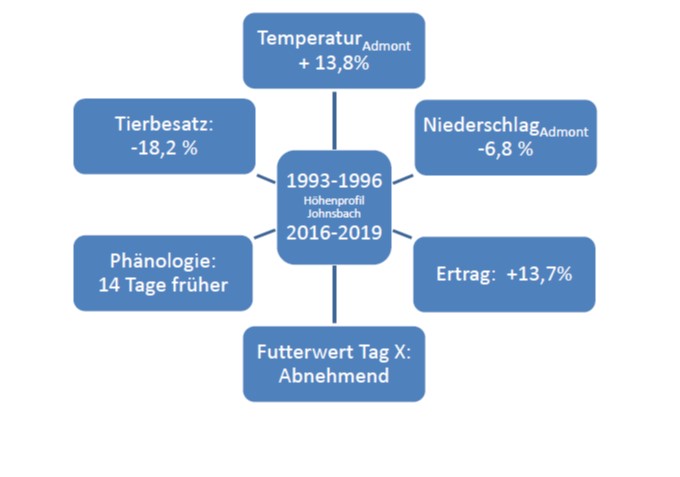10 days before this date and 10 days after, a remaining third was harvested in order to determine the development dynamics of the alpine forage. The yield in the first growth and the nutrients in the feed were determined. To investigate climate change, the long-term data set from the ZAMG station in Admont between 1990 and 2019 was evaluated. Its suitability was checked in advance via the local measuring station network of the Johnsbachtal Integrative Cooperation Platform. The climate scenarios for Austria from the ÖKS15 working group are used for future forecasts (ÖKS15 2015).
The study of climate data showed, compared to the first period from 1993-1996, an increase in temperature in the respective month before harvest by 13.8% or 2.1 ° C and a decrease in precipitation by 6.8% or 10 mm. The warming led to an earlier start to vegetation of around 14 days, which is why there was already 13.8% more forage yield by the fixed harvest date. This feed was at least one phenological phase further and was now no longer at the pasture maturity observed in 1993-1996, but at least in flowering. In connection with this, a changed composition of the structural carbohydrates could be observed. Along the developmental dynamics of vegetation, plants store more structural carbohydrates along the elevation gradient. Overall, the feed value therefore decreases. In order to react to this development, alpine farmers must not set the alpine grazing date too late in the future. Traditional dates or legally anchored dates must definitely be reconsidered, as the start of grazing could take place a further 5 weeks earlier from today using the ÖKS15 forecasts up to the period 2071-2100. This statement applies to locations with sufficient rainfall in spring and early summer. Over the entire observation period, the number of grazing livestock also fell by 18.2% as a result of the structural change in agriculture. The stronger dynamics of the vegetation and the decline in grazing animals will lead to a further decline in quality pastures on the alpine pastures in the future. As countermeasures, systematic grazing and continued active pasture care by alpine farmers are absolutely necessary. It goes without saying that agriculture in the mountain area must remain intact.
1 2022 graphic guggenberger
 Caption text
Caption text







